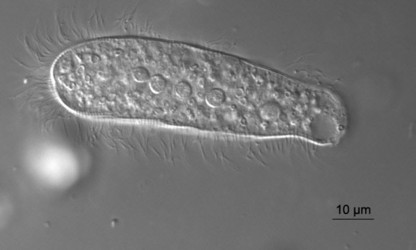Opalinids
- Cepedea
- Opalina
- Protoopalina
- Zelleriella
Characteristics
- Colorless, heterotrophic protists with multiple flagella found as endosymbionts (commensals) in the hindgut of cold-blooded vertebrates (e.g., frogs, toads and fish).
- The trophic stage is apparently diploid.
- When swimming the flagella beat in a metachronal fashion.
- Individual cells contain multiple nuclei that are typically conspicuous.
- Cells are covered by a furrowed or pleated (folded) pellicle.
- A falx is present at the anterior ends of cells from which flagella (and their basal bodies or kinetids) on the somatic cell body arise following cell division. During cell division the falx is bisected by a line parallel to, or oblique to, the anterior-posterior axis of the cell.
- Endosymbiotic opalinid trophic and reproductive stages are apparently microaerophilic.
- The organisms lack a cytostome (mouth) and obtain nutrition by pinocytosis.
- Asexual reproduction is via binary fission (more-or-less longitudinal) and the nuclear envelope remains intact during mitosis.
- Motile, uninucleate, haploid anisogametes (gametes of different sizes) are produced via meiosis that resemble the mother cell in miniature. Anisogametes fuse giving rise to diploid cells.
- Small cysts with reduced numbers of nuclei are passed out of the host’s body in fecal material.
Biodiversity
Four opalinid genera are presently recognized: Cepedea, Opalina, Protoopalina, Zelleriella. These genera are separated from one another based upon the shape of the organism in cross-section and the number of nuclei per cell. According to Corliss (1990) over 400 opalinid species have been described but the actual number of species is likely to be much lower. Species placed in Cepedea and Opalina possess numerous nuclei per cell whereas Protoopalina and Zelleriella are binucleate.
References
Adl SM, Simpson AGB, Farmer MA, Andersen RA, Anderson OR, Barta JR, Bowser SS, Brugerolle G, Fensome RA, Fredericq S, James TY, Karpov S, Kugrens P, Krug J, Lane CE, Lewis LA, Lodge J, Lynn DH, Mann DG, McCourt RM, L. Mendoza L, Moestrup Ø, Mozley-Standridge SE, Nerad TA, Shearer CA, Smirnov AV, Spiegel FW, Taylor MJ (2005) The new higher level classification of eukaryotes with emphasis on the taxonomy of protists. J Eukaryot. Microbiol 52:399-451
Andersen RA, Barr DJS, Lynn DH, Melkonian M, Moestrup Ø, Sleigh MA (1991) Terminology and nomenclature of the cytoskeletal elements associated with the flagellar/ciliary apparatus in protists. Protoplasma 164:1-8
Cavalier-Smith T (1993) The protozoan phylum Opalozoa. J Euk Micobiol 40:609-615
Cavalier-Smith T (1997) Sagenista and Bigyra, two phyla of hetertrophic heterokont chromists. Archiv Protistenk 148:253-267
Cavalier-Smith T, Chao EE-Y (2006) Phylogeny and megasystematics of phagotrophic heterokonts (Kingdom Chromista). J Mol Evol 62:388-420
Corliss JO (1990) Class Opalinata. In Margulis L, Corliss JO, Melkonian M, Chapman DJ [eds] Handbook of Protoctista, pp. 239-245. Bartlett and Jones Publishers, Boston, MA, USA.
Delvinquier B, Patterson DJ (1993) The Opalines. In: Parasitic Protozoa. Academic Press. pp. 247-325
Kostka M, Hampl V, Cepicka I, Flegr J (2004) Phylogenetic position of Protoopalina intestinalis based on SSU rRNA. Mol Phylogenet Evol 33:220-224
Lee JJ, Leedale GF, Bradbury P (eds) (2000) An Illustrated Guide to the Protozoa, 2nd Ed. Allen Press, Lawrence, KS.
Margulis L, Corliss JO, Melkonian M (eds) (1990) Handbook of Protoctista. Jones and Bartlett Publishers, Boston, MA.
McKeal JR, Kuehl JV, Boore JL, de Pamphilis CW (2007) Complete plastid
Nishi A, Ishida K, Endoh H (2005) Reevaluation of the evolutionary position of opalinids based on 18S rDNA, and a- and b-tubulin gene phylogenies. J Mol Evol 60:695-705
Patterson DJ (1999) The diversity of eukaryotes. The American Naturalist 154:S96-S124
Patterson DJ (1989) Stramenopiles: chromophytes from a protistological perspective. In Green JC, Leadbeater BSC and Diver WL (eds) The Chromophyte Algae: Problems and Perspectives. Clarendon Press, Oxford. Pp 357-379
Patterson DJ (2002) Residual heterotrophic stramenoplies. In Lee JJ, Leedale GF, Bradbury P (eds) An Illustrated Guide to the Protozoa. Society of Protozoologists, Lawrence, Kansas pp 751-754.
Title Illustrations

| Scientific Name | Opalinid |
|---|---|
| Location | Wilmington, NC |
| Specimen Condition | Live Specimen |
| Copyright |
© 2010 J. Craig Bailey

|
| Scientific Name | Opalinid |
|---|---|
| Location | Wilmington, NC |
| Specimen Condition | Live Specimen |
| Copyright |
© 2010 J. Craig Bailey

|
About This Page
Page copyright © 2010
 Page: Tree of Life
Opalinids.
The TEXT of this page is licensed under the
Creative Commons Attribution-NonCommercial License - Version 3.0. Note that images and other media
featured on this page are each governed by their own license, and they may or may not be available
for reuse. Click on an image or a media link to access the media data window, which provides the
relevant licensing information. For the general terms and conditions of ToL material reuse and
redistribution, please see the Tree of Life Copyright
Policies.
Page: Tree of Life
Opalinids.
The TEXT of this page is licensed under the
Creative Commons Attribution-NonCommercial License - Version 3.0. Note that images and other media
featured on this page are each governed by their own license, and they may or may not be available
for reuse. Click on an image or a media link to access the media data window, which provides the
relevant licensing information. For the general terms and conditions of ToL material reuse and
redistribution, please see the Tree of Life Copyright
Policies.
- First online 28 April 2010
- Content changed 28 April 2010
Citing this page:
Tree of Life Web Project. 2010. Opalinids. Version 28 April 2010 (under construction). http://tolweb.org/Opalinids/142201/2010.04.28 in The Tree of Life Web Project, http://tolweb.org/










 Go to quick links
Go to quick search
Go to navigation for this section of the ToL site
Go to detailed links for the ToL site
Go to quick links
Go to quick search
Go to navigation for this section of the ToL site
Go to detailed links for the ToL site